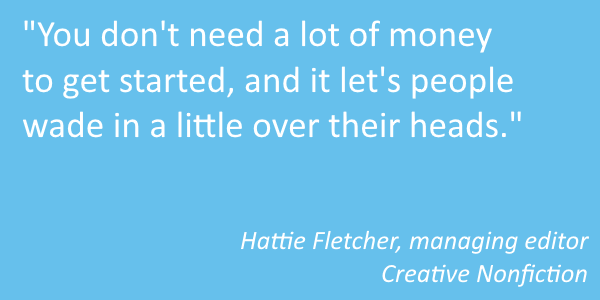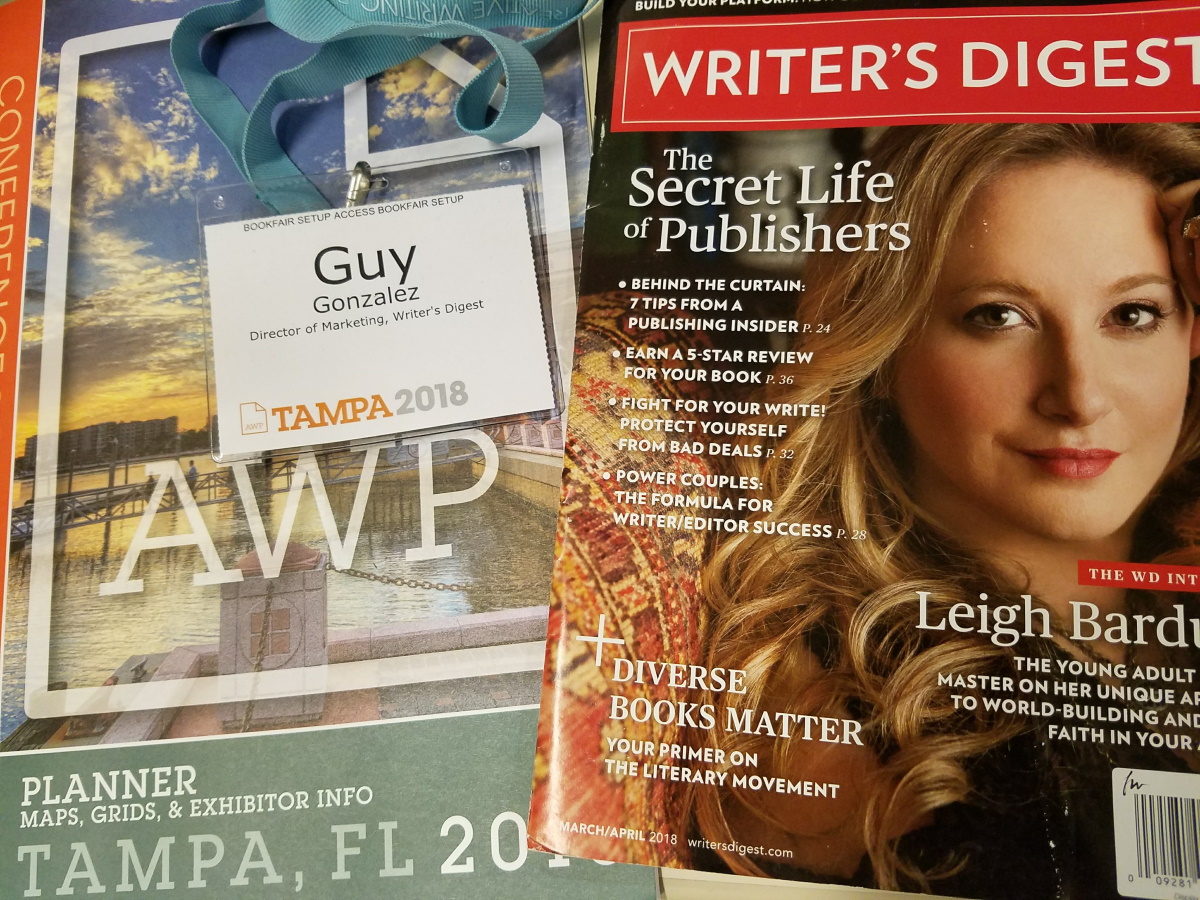My first time attending AWP last week drove a weird swirl of emotions as it ended up being an unexpectedly familiar mix of old and new-old worlds colliding, with a pleasant dash of deja vu and a still-lingering aftertaste of cautious optimism. While I spent the first two days in the Bookfair for the day job having conversations with an interesting cross-section of poets, writers, and writing professors, I also ran across a ton of poets from a previous life, some in person, many more represented on the tables of a surprisingly diverse mix of literary publishers (relatively speaking, at least).
On Saturday morning I was able to squeeze in a couple of sessions before my flight home and lucked into an insightful 1-2 punch that was right up my alley—”The Thing Builders: Building Literary Communities That Matter” and “Literary Innovation: Staying Solvent and Relevant in a Changing Publishing Landscape“—leaving me thinking the literary world may finally be catching up to Richard Nash’s provocative vision for Cursor and a more sustainable future.

There’s a U in Community
I’ve been a firm believer in the value of building communities from my earliest days in the slam scene at the Nuyorican Poets Cafe to my various day jobs in publishing and marketing over the past 20+ years, and was nodding my head in vigorous agreement with Torch Literary Arts founder Amanda Johnston’s advice during the Thing Builder session: “What are your intentions? Clarify your goals. Focus. Be flexible.“
There is always a slightly selfish aspect to community building—you have to be personally invested—but if it’s more “I…” than “We…,” what you’re building might not be sustainable in the long term.
One could reasonably argue there were TOO MANY publishers at the Bookfair when you think about the relatively small markets they cater to for literary fiction, poetry, and creative nonfiction, as well as the often myopic focus on a single magazine, ignoring or discounting other ways they could serve their community while ensuring a sustainable future.
The relatively low barrier for entry into (and expectations of) literary publishing “let’s people wade in a little over their heads,” and many publishers often find themselves living on the brink of insolvency, one time-consuming fundraising pitch away from failure.
Because it’s easier than ever to launch a literary journal, especially online, and many are born from an admirable desire to support the work of like-minded poets and writers, sustainability isn’t usually one of the first things founders think about. I suspect many new presses have been conceived while walking the Bookfair aisles over the years, and most of them fold before achieving any noteworthy goals or literary impact.
The panelists in the Thing Builder session shared one common trait: they had clearly defined goals, ensured everything they did aligned with them, and were fully invested in reaching those goals. Each connected a personal desire to a larger need, started small, and engaged their respective communities to help them succeed.
- Started as a student project, she wanted to create something that would outlast her MFA. (Penny Guisinger, Iota)
- Inspired by traveling salons from the Harlem Renaissance, she wanted to celebrate new, emerging, and unheralded writers, small independent presses, and marginalized voices. (Juliet Howard, Women Writers in Bloom Poetry Salon)
- She wanted to fill a gap that wasn’t being served and affected her personally—spaces for black women. (Amanda Johnston, Torch Literary Arts)
- Created a supportive environment for creative nonfiction writers; a space to share, meet, and collaborate. (Janna Marlies Maron, Under the Gum Tree)
“Not everyone has the internal gumption to build something,” said Maron. “If you are that person, invite people to participate.”
“Community is collaboration,” said Howard. “You can’t do it all on your own, even as a solo curator.”

Your Community Can Sustain You
Building and serving communities—of writers, readers, or ideally, both—can be a personally fulfilling experience driven by the best of intentions, but it’s not always a financially stable endeavor, especially if you have other people involved as more than volunteers.
“Depending on what you’re trying to achieve, there are a variety of business models,” explained [former colleague, long-time friend, and all-around publishing expert] Jane Friedman, setting the stage for the Literary Innovation session. “You can’t survive just publishing great stuff.”
“Solvency is sustainability,” said Yi Shun Lai, nonfiction editor at Tahoma Literary Review and session moderator. “Can we continue to pay our writers increasing rates? Pay our staff? Support the literary community?”
“You don’t need a lot of money to get started,” noted Creative Nonfiction‘s Hattie Fletcher, “and it let’s people wade in a little over their heads.”
Midwestern Gothic co-founder Robert James Russell noted the need to overcome “the stigma” of literary journals and reach readers beyond AWP was critical to any publisher’s long-term sustainability.
Making the jump from a free online journal or one-shot magazine publishing your friends and writers happy for exposure, to a sustainable business that pays its staff and contributors while reaching new audiences is a tall order, something precious few of those on display at the Bookfair are actually doing in any noteworthy way.
[Speaking from personal experience… SPINDLE. RIP]
Friedman noted the “demand curve” as an opportunity for publishers, a core tenet of Nash’s Cursor model which was arguably… ahem, too far ahead of the curve in 2010:
“The model of $15-$25 books is a radically insufficient way to capture all the value Lynne Tillman creates,” he says. “People pay tens of thousands of dollars to do an MFA where she teaches. To my mind that’s the top of [her] demand curve.” To capitalize on some of that and to strengthen the author-reader relationship, Nash will have Tillman teach classes and workshops based on her books. He’ll also publish four of her backlist titles.
My primary, cautiously optimistic takeaway from #AWP18 is that the literary world may finally be catching up to Nash’s vision, one that’s already played out in traditional media where magazine publishers have expanded their offerings to include live events, online education, and merchandise, augmenting legacy paid subscription models and ubiquitous (and mostly free) online content.
Back in 2010, the technology needed to effectively pull this off was too expensive, too new and unproven, and/or too complicated for small literary operations, but in 2018, all the necessary pieces are on the table for even the smallest literary publisher to take the next step. One could arguably get started with a simple combination of WordPress, MailChimp, Hangouts, Patreon, and a good relationship with their local library.
Of course, Johnston’s fundamentals still apply: “What are your intentions? Clarify your goals. Focus. Be flexible.”
Regarding Torch Literary Arts, she noted: “It wasn’t meant to grow. It was meant to last. It’s still there.”
Align your goals with your community’s needs, find the right tools to help you serve them effectively and efficiently, and ensure every step forward is a sustainable one.
Do you like email?
Sign up here to get my bi-weekly "newsletter" and/or receive every new blog post delivered right to your inbox. (Burner emails are fine. I get it!)


